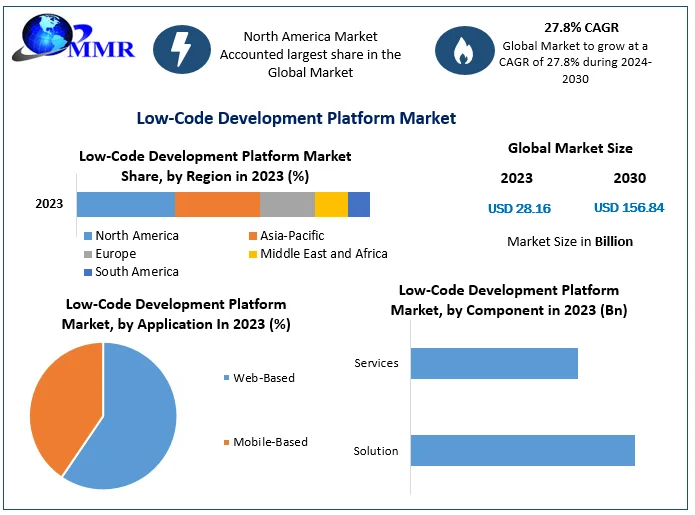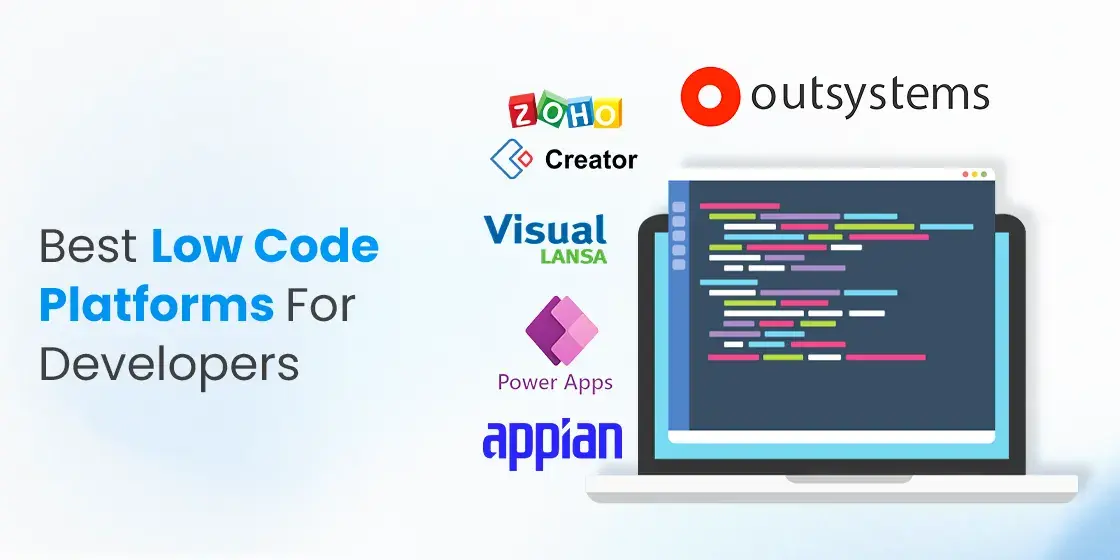Handy Tips To Deciding On application development with Low-code platforms
Handy Tips To Deciding On application development with Low-code platforms
Blog Article
The Advantages Of Low-Code Development For Application Development As It Relates To Integration Capabilities
Low-code development of applications offers huge advantages when it comes to integration capabilities, which are crucial for building applications that seamlessly connect with various platforms and services. Here are the major advantages: Pre-built connectors and APIs:
Wide range of connectors: Low code platforms come with an extensive collection of pre-built connectors to the most popular enterprise systems (e.g. CRM, ERP databases, cloud services). This makes it easier to integrate with these systems.
API Integration: Many low code platforms come with out-of the-box integration API capabilities that let developers easily connect with external services and sources of data.
Easy to use
Drag-and-Drop Integration Tasks for integration can typically be done using drag-and drop interfaces, which makes it easy for both developers and non-developers to create complicated integrations without writing a lot of code.
Visual Workflow Builders Visual tools to create workflows and data flow aid in understanding and setting up integrations more intuitively.
Standardized Integration Methods:
SOAP and Restful Service: Using standard web service protocols such as SOAP and REST makes it simple to connect other systems and applications.
OData Standards: OData standards permit the simple manipulation and retrieval of data across different platforms and apps.
Real-Time Data Synchronization:
Low-code platforms allow for real-time integration between systems and applications. This allows information to be kept up-to-date and consistent across all departments of the company.
Event-Driven architecture: Some platforms can support event-driven architectures. This lets applications respond to events in real-time, which is essential for dynamic and interactive apps.
Legacy System Integration:
Low-code platforms are frequently used to integrate legacy systems. This allows organizations to modernize IT infrastructures without having to completely overhaul existing systems.
Data Migration Tools Built in data-migration tools make it simple to move data from old systems to low-code applications.
Integration of Third Party Services:
Integration with Cloud Services: Seamless integration with cloud-based services like AWS, Azure, and Google Cloud allows for the simple deployment and scaling of applications.
Business Applications Integration : Low-code platform is able to integrate with a variety of applications for business, like Salesforce.com, SAP, Microsoft Dynamics and others for seamless workflow across different business processes.
Simple data management:
Unified Data Models Some low-code platforms provide unification of data models, which simplify the management of data and integrate across different systems.
Data connectors: Preconfigured data connectors allow easy access and modification on data from various sources.
Security and Compliance
Low-code integration platforms meet security standards that protect the data during transport or at rest.
Security Features: These platform typically have features that assure that integrations are in compliance with the requirements of regulatory agencies, like GDPR and HIPAA. This provides security for companies handling sensitive data.
Extensibility:
Custom Codes and Scripts. To meet more intricate requirements in integration, low-code platforms often allows the inclusion custom code and scripts. This allows flexibility without compromising user comfort.
Plug-in Ecosystems. A network of plug-ins and extensions will allow you to further enhance the capabilities of integration, while adding new features whenever you need to.
The overall low-code platform's integration capabilities can be a very effective tool for developing interconnected apps which are scalable and efficient. These platforms simplify the process of connecting disparate IT systems, increase the flow of data, and aid companies adopt technologies that are already in use, and also make use of new ones. Follow the best his comment is here for website info including mobile app development platforms, cross platform mobile dev, developing mobile apps, azure sql server, stored sql procedures, develop web app, cross platform mobile dev, azure sql server, mobile development platforms, app platforms and more.
Cost-Effectiveness Is Among The Many Advantages Of Developing Apps Using Low-Code.
Low-code development offers a number of advantages when it comes to cost-effectiveness. Businesses that are seeking to reduce costs can take advantage of this approach while also delivering high-quality applications. These are the major benefits reduction in development costs:
Lower Coding Requirements: Low programming platforms eliminate the need to code manually and save developers time as well as money. The result is lower labour costs.
Fewer Developer Resources: Since low-code development is faster and simpler, fewer specialized developers are required. It can reduce hiring and staffing costs.
Time to market faster:
Accelerated Development Cycle: The visual tools for development and the pre-built parts offered by low-code platforms allow for rapid development of applications, which allows companies to get their products on the market more quickly. This will result in faster revenues and better positioning in the market.
Rapid Prototyping: Businesses can develop and test prototypes in a very short amount of time, which reduces the amount of time required for the development phase. This allows them to create faster the next iteration after receiving feedback from users.
Low Maintenance Costs
The modular design and standard components of applications developed with low-code platforms makes them simpler to maintain. This helps reduce the cost of ongoing maintenance.
Automated Patches and Updates Low-code platforms are able to handle patching and updating applications completely. This means that the application is safe and always up to date without extensive manual intervention.
Efficient Resource Utilization:
Contributions from Non-Developers Low-code platforms permit business users and non-developers alike to be part of the process of development. This democratization of development allows businesses to leverage the skills of a wider variety of employees, thus reducing dependence on highly-paid developers.
IT departments can focus on Strategic Initiatives instead, of being bogged down by routine development tasks, IT departments are able to concentrate their energies on strategic initiatives that increase the efficiency and productivity of their departments.
The Scalable Pricing models
Subscription Pricing: A lot of platforms that use low-code provide flexible pricing models based on subscriptions which are scalable according to usage. This lets businesses match their spending to their real needs and growth.
Pay-as-you-go: Certain platforms allow pay-as-you-go. This allows businesses to only pay for resources they actually use. This is especially beneficial for small businesses and startups with limited budgets.
Reduce the cost of third-party software:
Low-code platforms are often equipped with integrated functionalities that eliminate the need to purchase extra software or tools. This could save you money on subscriptions and software licensing costs.
Pre-Built Integrations: The existence of pre-built integrations with popular platforms and services eliminates the requirement for custom-built development, which saves both time and money.
ROI Boosted
Increased Return on Investment Accelerating development and lower costs and a quicker time to market, businesses will see a greater return on investments (ROI).
Improved agility. Businesses can quickly adapt market changes and customer requirements to ensure they are relevant. They also can capitalize on new business opportunities that occur.
Costs of training are lower:
Low-Code Platforms have User-Friendly Interfaces. The user-friendly and intuitive interfaces cut down on the learning curve of novice users. This eliminates the need for intensive training programs.
Accessible resources Low-code platforms often have extensive tutorials, training materials, and community assistance and help, which can reduce the need for formal education.
Collaboration is streamlined:
Enhanced collaboration Tools: The integration of collaboration tools allows improved communication between team members and a reduction in project overhead.
Unified Development Environment: A single unifying development environment can help streamline workflows and reduces the complexities and costs associated with managing multiple tools and platforms.
Low-code development is cost effective because it lowers maintenance and development expenses. It also speeds up time to market and optimizes resource usage. Pricing models are flexible. These aspects provide significant financial advantages to companies and make low-code a compelling option for organizations looking to maximize their budgets and achieve robust, scalable, high-quality apps. Read the top rated Legacy application modernization with Low-code recommendations for blog recommendations including paas service, rad development, cloud software applications, app development platform, build a docker container, application modernisation, app development platform, build a docker container, ms azure sql, develop web application and more.
In Terms Of Vendor Support And Community, Low-Code Applications Development Offers Many Benefits.
Low-code applications development platforms are a great option to obtain vendor support as well as community involvement. Both of these factors are essential to ensure an effective implementation and continuous maintenance of the app. Here are the major benefits: Support from the vendor
Comprehensive Technical Support:
Dedicated Support Teams A lot of low-code platforms have dedicated support teams who can help in technical problems, problem-solving and provide guidance. This ensures that any problems are quickly resolved.
24/7 Support: Some vendors are available 24/7 and this is helpful for businesses operating in multiple time zones.
Training and Onboarding
Vendors typically offer user-friendly programs including tutorials or webinars. They can also offer training courses for certification.
Personalized Onboarding: A lot of vendors provide personalized onboarding services to help new customers use the platform effectively and tailor it to their particular requirements.
Regular updates and enhancements
Continuous Improvements: Low-code companies regularly release updates that include performance enhancements as well as new features and security patching, to keep the platform up-to-date.
Feedback Integration: Vendors often incorporate user feedback into their development cycles, making sure that their platforms evolve to meet the evolving needs of its users.
Comprehensive Documentation:
Documentation is thorough users are able to access extensive and well-organized documents, ranging in complexity from simple modification to advanced.
API References API documentation can aid developers customize and integrate applications using the Low-Code platform.
Consulting and Professional Services:
Expert Consulting: Vendors often provide consulting services to help with planning for strategic purposes architectural design, as well as complex implementations to ensure that users have the ability to leverage the platform to its fullest potential.
Custom Development: Some vendors provide services that permit the development of specific features, or incorporate systems that aren't offered from the beginning.
Community Support
Active User Communities
Discussion boards and forums A lot of platforms with low-code feature a vibrant community for users to get help, discuss solutions and collaborate to find the best techniques.
User Groups & Meetups User Groups and Meetups: Local or virtual groups and meetings offer opportunities to learn, network and sharing your experiences.
Knowledge Sharing and Collaboration
Community-Contributed Resources: Users often share templates, modules, and extensions that they have developed, which can be reused or adapted by others, accelerating development and innovation.
Crowdsourced Solution Finding: The collective experience and wisdom of a group can be an excellent resource for solving complex issues.
Learning and Development
Community-Led Training: Many communities host training sessions, workshops, and webinars, often led by experienced users who offer practical tips and advanced techniques.
Online Tutorials: The community members make and share a variety of online tutorials, how-tos, and classes. These resources are made available to everyone.
Feedback and Influence
Product Feedback Channels Community forums offer a variety of channels for providing feedback to vendors, which can influence the design of new features.
Beta Testing Programs - Members of the community might be eligible to participate in beta testing programs. This gives them an early look at new features, as well as the opportunity to influence the future of the platform.
Recognition and support
Community Recognition Programs: Many vendors have recognition programs to recognize the efforts of active members of their communities, including MVP (Most Valuable Professionals) programs.
Peer support: Community members tend to be willing to provide peer-support, offering their expertise and advice to those who may be less experienced. They foster a collaborative environment through encouraging collaboration and a supportive atmosphere.
The combination of robust vendor support, and an engaged, active community creates a broad ecosystem of support for development with low-code. It ensures users have the resources, expertise, as well as collaborative opportunities that they require to be able to build and launch their applications.